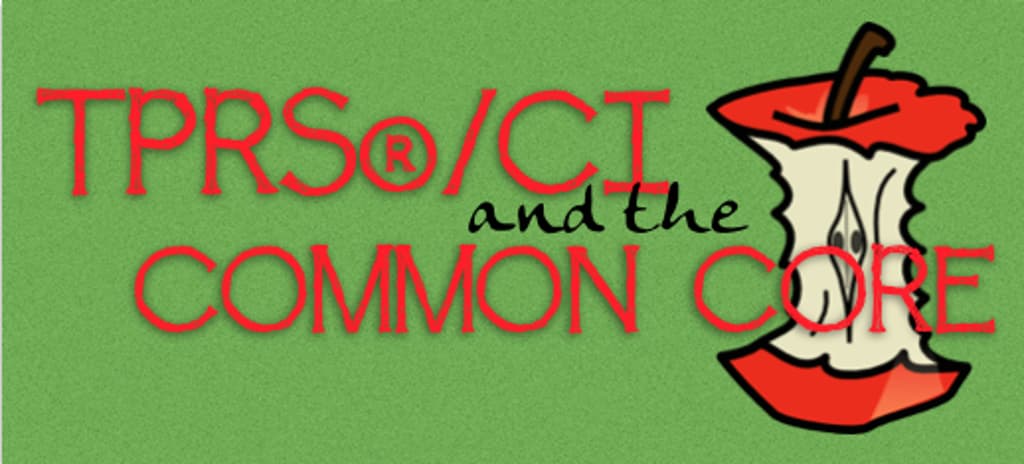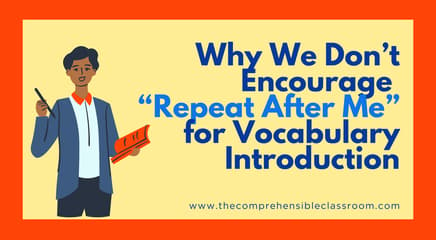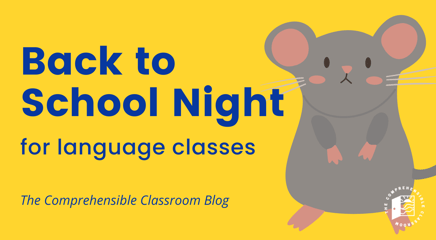Over the last year, I have received many email requests from teachers, administrators, and conference planners that need to know how TPRS® and other Comprehensible Input strategies meet Common Core standards. Teachers must explain the connections so that they are permitted to use these best practice strategies in their classrooms, administrators seek to know whether or not to approve their teachers’ proposed instructional methods, and conference planners must defend their offerings in order for conference attendees to receive funding from the institutions that they represent. All of this pressure has created much stress for all parties involved, but when we take a moment to examine TPRS®/CI through the lens of the Common Core Standards, we quickly see that there is absolutely no reason to freak out!
One of the beautiful things about TPRS® is that it has been meeting Common Core Standards since before the standards existed. A quick glance through the CC Reading, Writing, Speaking, and Listening standards will leave those familiar with TPRS® and other Comprehensible Input strategies nodding their heads in agreement. When teachers use a variety of the TPRS®/CI strategies available to them, they easily address Common Core Standards in their classes on a daily basis. Below are just a few of the connections that I see between TPRS®/CI and the Common Core--the list is certainly not exhaustive. To learn more about the content and strategies mentioned in this post, consider attending iFLT or NTPRS this summer. Individual sessions at both conferences will help you to address unique standards. By attending either conference in its entirety, you will leave with a toolbox full of strategies to address Common Core standards in your language classes!

PERSONALIZED QUESTIONS AND ANSWERS (PQA)
- CCSS.ELA-Literacy.SL.9-10.1 Initiate and participate effectively in a range of collaborative discussions (one-on-one, in groups, and teacher-led) with diverse partners on grades 9–10 topics, texts, and issues, building on others’ ideas and expressing their own clearly and persuasively.
While TPRS®/CI teachers focus on Comprehensible Input, teacher-led output is at the very core of TPRS®. PQA (Personalized Questions and Answers) is a collaborative class discussion that TPRS®/CI teachers use to begin almost every single class period. We know that students must maintain interest in the content in order to keep the affective filter low, and there is nothing that students love more than talking about themselves and their world! PQA is a time when teachers ask questions to the class that include the target structures, and then re-state student responses and reflect them to the class for questioning and conversation in order to provide more repetitions of the target structures. The topics range greatly depending on what is going on in the students’ lives and the world and what the class is studying.
While it is true that one on one and small group discussions are less frequent in lower levels, many TPRS®/CI teachers strive for 5-10 minutes of output per day, even at the novice level, to accustom students to speaking. These snippets of conversation often take place 1:1 or in small groups, and they range in topic from the students’ lives to the story that was created in class to the topic that was presented and discussed in class (often of cultural or historical significance). Many teachers (Laurie Clarcq comes to mind) work closely with the “core” departments at their schools to align the World Language curriculum with that of their core classes. For example, if students are reading “Romeo and Juliet” in English, the WL teacher creates a parallel story to use in his/her class so that the students can compare and contrast and discuss themes. For this reason, the conversations that take place are often academic in nature even in classes that appear on the surface to be fiction-based.
AUTHENTIC RESOURCES
- CCSS.ELA-LITERACY.CCRA.R.7 Integrate and evaluate content presented in diverse media and formats, including visually and quantitatively, as well as in words.
It is no secret that authentic resources are of great value to language learners, and for that reason they have been the highlight of many presentations at state, regional, and international language conferences throughout the past several years. By examining lists of their benefits (see one such list here), it is easy to see that TPRS®/CI teachers love to use authentic resources in upper level classes as a source for discussion and content. However, the strategies that TPRS®/CI teachers have mastered in order to make input comprehensible to students allow even novice-level teachers the ability to use authentic resources in their classrooms. (TPRS®/CI guru Kristy Placido (www.kplacido.com) has presented on this subject many times.) Whether the resource is a commercial, an infograph, an article or blog post, or a piece of art, TPRS®/CI teachers are constantly on the lookout for materials that will pique their students’ interest in the target language and culture and further their understanding of the topic at hand.
LEVELED READERS
- CCSS.ELA-LITERACY.CCRA.R.9 Analyze how two or more texts address similar themes or topics in order to build knowledge or to compare the approaches the authors take.
- CCSS.ELA-LITERACY.CCRA.R.10 Read and comprehend complex literary and informational texts independently and proficiently.
- CCSS.ELA-LITERACY.CCRA.L.4 Determine or clarify the meaning of unknown and multiple-meaning words and phrases by using context clues, analyzing meaningful word parts, and consulting general and specialized reference materials, as appropriate.
Comprehensible Input without leveled readers is like a hot dog without a bun—some people use one but not the other, but it is just so much better when they are together! Repeated exposure to a variety of level-appropriate, written texts is not only one of the Common Core State Standards, but it is also an important tenet of Comprehensible Input practitioners. Krashen’s theory of Comprehensible Input (an umbrella term that encompasses five hypotheses) states that fluency increases when input is received at level i+1. In other words, we become more fluent in a language when we hear or read language that it just one step above our current level of fluency. Leveled readers allow language students to do just that because teachers can select texts for their students that meet their language needs based on unique word count, tense and perspective, and overall word count. Students are introduced to a limited number of new structures in context, allowing them to use the same reading strategies being taught in English Language Arts classrooms across the country in order to determine the meaning of word parts, words, and phrases. Because our goal is to improve fluency in the target language, we teach those same reading strategies in our classes, too! With a range of leveled readers available, TPRS®/CI teachers often have a library filled with books from which their students can select to read independently during Free Voluntary Reading (FVR) or even outside of class. Whether fiction or non-fiction, leveled readers provide yet another textual format for teachers to include in thematic units, providing increased opportunities for analysis of content and form.
MOVIE TALK
- CCSS.ELA-LITERACY.CCRA.R.7 Integrate and evaluate content presented in diverse media and formats, including visually and quantitatively, as well as in words.
- CCSS.ELA-LITERACY.CCRA.SL.2 Integrate and evaluate information presented in diverse media and formats, including visually, quantitatively, and orally.
- CCSS.ELA-LITERACY.CCRA.R.9 Analyze how two or more texts address similar themes or topics in order to build knowledge or to compare the approaches the authors take.
Movie Talk is an ESL technique developed by Dr. Ashley Hastings that was brought to the CI world by Michele Whaley (www.mjtprs.wordpress.com). While many TPRS®/CI teachers and trainers had used similar techniques in the past, Movie Talk took the CI world by storm in 2012 after Michele began posting demos on her blog. Now, many would consider it to be an essential tool in the CI tool belt. Movie Talk allows teachers to vary the input that they provide, and it allows teachers to transform otherwise-incomprehensible video sources into Comprehensible Input. In this way, teachers have access to a nearly unlimited selection of “texts” that can be used in combination with things like short stories, novels, articles, poems, songs, and discussion in order to explore topics from different angles and use vocabulary in diverse contexts. With Movie Talk, TPRS®/CI teachers “comprehensify” commercials, music videos, short films, and clips from long films, making them accessible to their students and greatly enriching the content of their classrooms.
COMPREHENSION CHECKS
- CCSS.ELA-Literacy.CCRA.R.4 Interpret words and phrases as they are used in a text, including determining technical, connotative, and figurative meanings, and analyze how specific word choices shape meaning or tone.
- CCSS.ELA-Literacy.CCRA.R.5 Analyze the structure of texts, including how specific sentences, paragraphs, and larger portions of the text (e.g., a section, chapter, scene, or stanza) relate to each other and the whole.
- CCSS.ELA-Literacy.CCRA.R.6 Assess how point of view or purpose shapes the content and style of a text.
Comprehension Checks are a continual presence in TPRS®/CI classrooms because the teacher must ensure that the input that students receive is truly comprehensible to them. The teacher must be acutely aware in every moment as to whether or not students comprehend the input and, if not, the point at which the breakdown in comprehension occurs. For this reason, TPRS®/CI ask a variety of targeted questions throughout every class period to individual students, small groups, and the whole class, asking students to do all of these things. Betsy Paskvan has presented many times on strategies for incorporating and diversifying comprehension checks in TPRS®/CI classrooms, and nearly every TPRS®/CI presentation or instructional material reiterates their importance.
STANDARDS BASED GRADING
- CCSS.ELA-Literacy.CCRA.R.1 Read closely to determine what the text says explicitly and to make logical inferences from it; cite specific textual evidence when writing or speaking to support conclusions drawn from the text.
- CCSS.ELA-Literacy.CCRA.R.2 Determine central ideas or themes of a text and analyze their development; summarize the key supporting details and ideas.
- CCSS.ELA-Literacy.CCRA.R.3 Analyze how and why individuals, events, or ideas develop and interact over the course of a text.
Due largely to the work of Scott Benedict at Teach for June (www.teachforjune.com), the majority of TPRS®/CI teachers use Standards Based Grading to the degree that it is possible within the confines of their school’s grading system. With Standards Based Grading, TPRS®/CI meet these three Common Core Anchor Standards with ease. We no longer require students to simply regurgitate facts on multiple-choice or fill-in-the-blank quizzes; instead, we require our students to prove their understanding of the text by supporting their answers with facts that they put in their own words. Teachers ask high-order thinking questions because students must have truly comprehended a text in order to respond to them. For this reason, “big picture” questions about theme and character analysis have become common-place in TPRS®/CI classrooms. In order to accurately assess our students’ mastery of a standard, we must push them to apply, analyze, synthesize, and evaluate the information that they glean from class discussions, cultural readings, film sources, fictitious texts, and more.
WRITING
- CCSS.ELA-Literacy.W.9-10.1 Write arguments to support claims in an analysis of substantive topics or texts, using valid reasoning and relevant and sufficient evidence.
- CCSS.ELA-Literacy.W.9-10.2 Write informative/explanatory texts to examine and convey complex ideas, concepts, and information clearly and accurately through the effective selection, organization, and analysis of content.
- CCSS.ELA-Literacy.W.9-10.3 Write narratives to develop real or imagined experiences or events using effective technique, well-chosen details, and well-structured event sequences.
- CCSS.ELA-LITERACY.CCRA.W.10 Write routinely over extended time frames (time for research, reflection, and revision) and shorter time frames (a single sitting or a day or two) for a range of tasks, purposes, and audiences.
Again, while the TPRS®/CI focus is on input–not output–writing remains a key component of their curriculum. Free Writes (which meet Standard W.9-10.3) are the most commonly used technique, but most trained TPRS®/CI teachers incorporate expository writing into their curriculums as they study history, culture, and contemporary issues in class. In many classes, students spend several days learning vocabulary, and then they use their newly acquired vocabulary to study a cultural topic. At the end of the week, they are required to write and speak about the cultural topic using the target vocabulary. (For examples of such units, please check out my Curriculum Map.) The production tasks require students to analyze, evaluate, and synthesize the information learned throughout the week in a new way so that the teacher can accurately assess students’ acquisition of the structures and comprehension of the material. They cannot produce it in the same way that they received it, and so they must write personalized arguments and truly synthesize the information in order to successfully complete the task.
I will reiterate that this list is not exhaustive. Please feel free to add any connections that you see in the comments section!
Copyright © 2014, Martina Bex - MartinaBex.com - All rights reserved
If you find yourself in need of a “TPRS®/CI and Common Core” defense, please contact me via email ([email protected]) to request express written consent to reproduce the information contained in this post. This post (along with all material posted on this blog) is copyrighted material.



